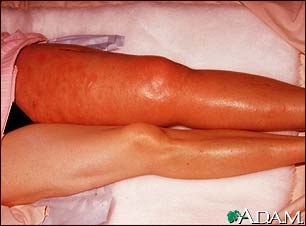Definition
Deep venous thrombosis is a condition in which a blood clot forms in a vein that is deep inside the body.
Overview, Causes, & Risk Factors
Deep venous thrombosis (DVT) mainly affects the large veins in the lower leg and thigh. The clot can block blood flow and cause swelling and pain. When a clot breaks off and moves through the bloodstream, this is called an embolism. An embolism can get stuck in the brain, lungs, heart, or other area, leading to severe damage.
Blood clots may form when something slows or changes the flow of blood in the veins. Risk factors include:
- After a pacemaker catheter has been passed through the vein in the groin
- Bedrest
- Cigarette smoking
- Fractures in the pelvis or legs
- Giving birth within the last 6 months
- Heart failure
- Medications such as estrogen and birth control pills
- Obesity
- Recent surgery (especially hip, knee, or female reproductive organ surgery)
- Too many blood cells being made by the bone marrow (polycythemia vera), causing the blood to be thicker and slower than normal
You’re also more likely to develop DVT if you have any of the following conditions:
- Blood that is more likely to clot (hypercoagulability)
- Cancer
- Taking estrogens or birth control pills. This risk is even higher if you smoke.
DVTs are most common in adults over age 60, but can occur at any age.
Sitting for long periods when traveling can increase the risk of DVTs. This is most likely when one or more of the risk factors listed above are also present.
Pictures & Images
Deep venous thrombosis, iliofemoral
 This picture shows a red and swollen thigh and leg caused by a blood clot (thrombus) in the deep veins in the groin (iliofemoral veins) which prevents normal return of blood from the leg to the heart.
This picture shows a red and swollen thigh and leg caused by a blood clot (thrombus) in the deep veins in the groin (iliofemoral veins) which prevents normal return of blood from the leg to the heart.
Deep veins

Veins in the extremities carry blood to the heart and lungs, where the blood is oxygenated. As the blood returns to the heart from the lungs, the arteries carry the oxygen-rich blood out to the body.
Venous blood clot

Deep venous thrombosis (DVT) affects mainly the veins in the lower leg and the thigh. It involves the formation of a clot (thrombus) in the larger veins of the area.
Deep veins

Veins in the extremities carry blood to the heart and lungs, where the blood is oxygenated. As the blood returns to the heart from the lungs, the arteries carry the oxygen-rich blood out to the body.
Venous thrombosis – series
Normal anatomy

Veins carry blood back to the heart from the tissues. Blood flowing in the veins is under lower pressure and moves more slowly than blood flowing in the arteries. Blood is therefore more likely to clot in the veins, thus blocking the flow through the veins.
-
Deep venous thrombosis : Overview, Causes, & Risk Factors
-
Deep venous thrombosis : Symptoms & Signs, Diagnosis & Tests
-
Deep venous thrombosis : Treatment



Review Date : 2/9/2010
Reviewed By : David C. Dugdale, III, MD, Professor of Medicine, Division of General Medicine, Department of Medicine, University of Washington School of Medicine. Also reviewed by David Zieve, MD, MHA, Medical Director, A.D.A.M., Inc.
